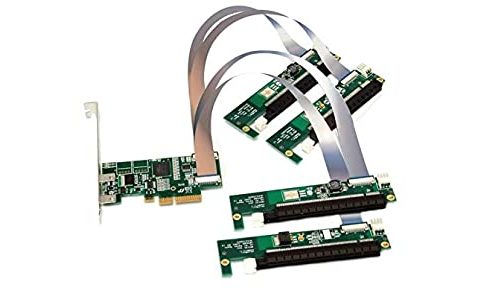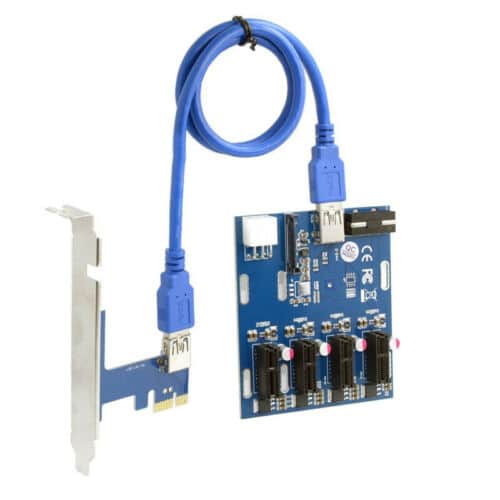You can add more PCIe Slots to your computer using a PCIe splitter. It would be best to have a free PCIe expansion slot on your motherboard to plug in a PCIe splitter, aka riser, which then fans out to multiple external PCIe slots.
Having the option to add more PCIe slots is essential if the selection of PCIe slots on your motherboard isn’t enough to accommodate more expansion cards.
While it is always wise to invest in a motherboard that meets your requirements from the start, if you do not have the budget to procure a new one, then PCIe splitters can help you.
Here I discuss in detail how to add more PCIe slots. However, it should be noted that the splitters DO NOT increase the bandwidth or the amount of PCIe lanes you have available!
Also, Read: How Many PCIe Lanes Do I Have?
TABLE OF CONTENTS
How to Add More PCIe Slots?
Having more PCIe slots means getting the opportunity to install more expansion cards for various uses. However, there are only two ways to increase the amount of PCIe slots you have:
- Invest in a new and a larger motherboard
- Invest in PCIe splitters
The first option is expensive and may not be viable if you already have a running system. Motherboards typically come with a fixed number of PCIe slots, which cannot be changed outside of getting a new board.
The second option is more straightforward, cheaper, and probably what you came here looking for.
What is Splitting PCIe Slots?
Splitting a PCIe bus into several smaller buses is known as PCIe Bifurcation.
The process results in several PCIe connections made available to the user, allowing for the installation of more cards than the motherboard would have independently allowed.
Splitters Do Not Increase Bandwidth and Lane Count!
While a splitter allows you to have more PCIe slots, an important point to remember is that you don’t get more bandwidth in doing so.
The entire setup will perform at the maximum supported speed of the host PCIe slot version and its lane count.
So even if the PCIe version of the splitter card is V3.0, if the slot on the motherboard to which it connects is V2.0, the bandwidth will conform to that of PCIe v2.0.
Furthermore, and this is very important to note, PCIe splitters DO NOT increase the lane count! If you split a single x4 slot into two x16 slots, you will not have 32 PCIe lanes. Instead, the bandwidth of the four lanes of the host card will be divided across the split ends.

Take the splitter above, for instance. So here, basically, an x4 host card splits into 4 x PCIe x16 slots. If each splitter is occupied, each connected device will be subject to the overall bandwidth provided by the x4 host slot.
So you cannot install four graphics cards on these and expect all of them to perform optimally for gaming. The performance will not even be close to optimal. Each graphics card is designed to use 16 PCIe lanes! They aren’t intended to be used on x4 slots for gaming, let alone on the 4-way split.
Splitters are great for GPU mining (Crypto mining), where your number of GPUs matters.
They are also great when installing multiple smaller cards like a network adapter, sound card, USB or SATA expansion cards, etc. Each of these cards utilizes only a single PCIe lane and thus would not saturate the host slot.
There Are Many Types and Configuration of Splitters

There are many types of PCIe splitters, and they come in many configurations. The splitter above is an external PCIe splitter.
This splitter connects to x1 slot on the board and then splits into four x1 slots for further expansion. So basically, the idea here is that the amount of bandwidth the cards occupy on the splitters should not be greater than the bandwidth provided by the primary x1 host slot connected to the motherboard.
So, for instance, if the host slot has a bandwidth of 1 GB/s, but the bandwidth demand of the four connected devices on the splitter exceeds this amount, then you will notice performance issues.
On the other hand, if the four connected devices have a lower bandwidth demand than 1 GB/s, they should work fine.
There can be more caveats when installing cards on the splitter, such as their quality. Therefore, it is always advised not to occupy all the split slots simultaneously. Instead, you should test and occupy slots one by one.
The Bandwidth of the Host Slot
The bandwidth of the host slot depends on factors like the size of the slot as well as the PCIe version:
| Version | x1 (GB/s) | x2 (GB/s) | x4 (GB/s) | x8 (GB/s) | x16 (GB/s) |
|---|---|---|---|---|---|
| 1.0 | 0.250 | 0.500 | 1.000 | 2.000 | 4.000 |
| 2.0 | 0.500 | 1.000 | 2.000 | 4.000 | 8.000 |
| 3.0 | 0.985 | 1.969 | 3.938 | 7.877 | 15.754 |
| 4.0 | 1.969 | 3.938 | 7.877 | 15.754 | 31.508 |
| 5.0 | 3.938 | 7.877 | 15.754 | 31.508 | 63.015 |
| 6.0 | 7.877 | 15.754 | 31.508 | 63.015 | 126.031 |
On a motherboard, an x1 slot has one lane, an x4 slot has four lanes, and an x16 slot can have 8 or 16 lanes.
A single PCIe 2.0 lane has 0.5 GB/s of bandwidth. A single PCIe 3.0 lane doubles this number and thus has 1.0 GB/s bandwidth. And so on. Each consecutive PCIe version doubles the bandwidth compared to its predecessor.
PCIe Splitter vs. PCIe Riser
PCIe splitters and PCIe risers are the same things.
The PCIe riser is most often used in the Crypto Mining circles. It is called a “riser” card because it lifts the installed cards above the motherboard.
Since a typical motherboard and a case does not have the space to accommodate the multiple graphics cards that a mining rig uses, “risers” are used to install the graphics cards externally.
The ordinary folks not so well versed with the Crypto Mining or PC jargon can settle with calling them PCIe splitters.
Also Read: Difference Between PCIe x1 and x16
PCIe Splitting is Highly Popular Among Crypto Miners
Also Read: How to Tell if RAM will Work with Your Motherboard?
Final Words
Now you know how to add more PCIe slots to your computer. Physically changing the number of slots on the motherboard is impossible. Fortunately, you can use the PCIe bus from one slot to run multiple devices.
However, as mentioned earlier, more slots do not equate to more bandwidth.
So while this method allows you to share the PCIe bus with many cards, you do not get better performance or increased bandwidths, just more devices over the same connection.
You have to ensure that the bandwidth demand of the connected cards does not exceed the supplied bandwidth from the host slot. Otherwise, there can be bottlenecking issues.
FREQUENTLY ASKED QUESTIONS
1. What factors should you consider before deciding to add more PCIe slots to your computer?
Before deciding to add more PCIe slots to your computer, you should consider the purpose of your computer and what devices you plan to use with the additional slots.
You should also consider the compatibility of your current motherboard with additional PCIe slots and whether adding more slots will require a power supply upgrade.
Additionally, you should consider the physical space inside your computer case and whether there is enough room to accommodate additional hardware.
2. Can you add more PCIe slots to a laptop, or is it only possible on a desktop computer?
Adding more PCIe slots to a laptop is generally not possible, as laptops are designed with a fixed number of PCIe slots.
However, some high-end gaming laptops may have additional PCIe slots that can be accessed by opening the case and installing additional hardware. In general, adding more PCIe slots is easier and more practical on a desktop computer.
3. What are some common mistakes to avoid when adding more PCIe slots to your computer?
When adding more PCIe slots to your computer, it is important to avoid common mistakes that can damage your hardware or cause other issues.
Some common mistakes to avoid include not properly grounding yourself before handling hardware, using too much force when installing PCIe cards, not properly securing PCIe cards in their slots, and not properly connecting power cables to the new hardware.
It is also important to ensure that any new hardware is compatible with your existing system and that you have the necessary drivers and software to properly use the new hardware.

Nice.
Is it the same to connect one GPU with a single riser to an 16x slot and a second GPU with a single riser to an 1x slot for mining? My mining software only recognizes 1 of the 2 cards.
Do you think a 4 card splitter installed in the 1x slot or 16x will make the 2 cards work? or should I go for another MOBO?
I have same problem. I used this spliter into pcie 2.0 x4 port, and i can see only 1 GPU in hiveOS (second show wrong values and nbminer don’t wanna start).
Where you able to find a fix?
I’m going through the same problem now.
I’m thinking switching the splitter to a full size PCIE-16 will fix the problem but haven’t tried it yet.
Change virtual memory, in advance system, according to your gpu gb, example, if u have 2 gpu of 12gb, 12000+12000=24000. Set and apply
Great article, thanks. I’ve got a small motherboard with only 2 PCIe slots in a large case and I need another now for an audio card. I was sure there was a way to add slots but didn’t know it was called a splitter/riser. Thanks for the clear, no jargon explanation. John
Thanks for the excellent article. Since PCI lanes are separate and are backward compatible, can a PCI-E x16 slot be utilized by a splitter that has an x16 connector that uses 4 separate X4 lanes for 4 different nvme SSDs? This may greatly increase the usage potential as a NAS.
Yes, I see no reason why a good quality splitter would not work in this configuration.